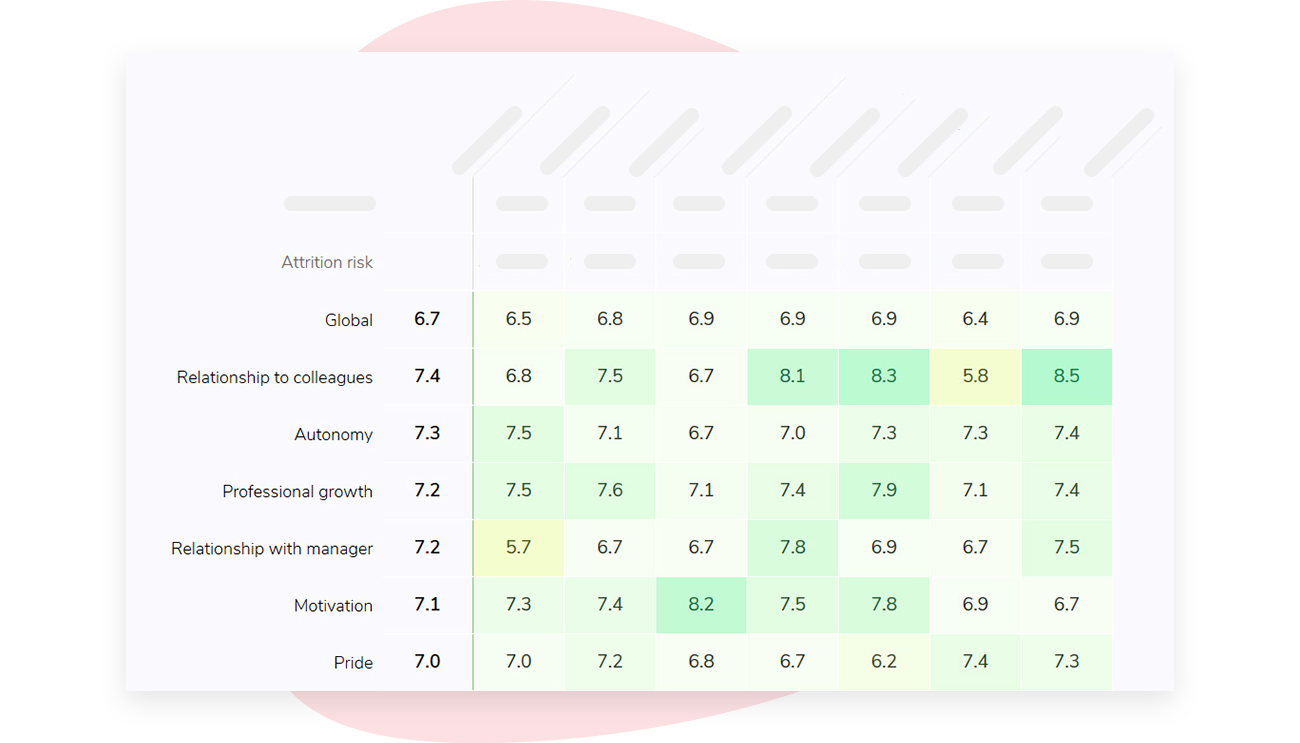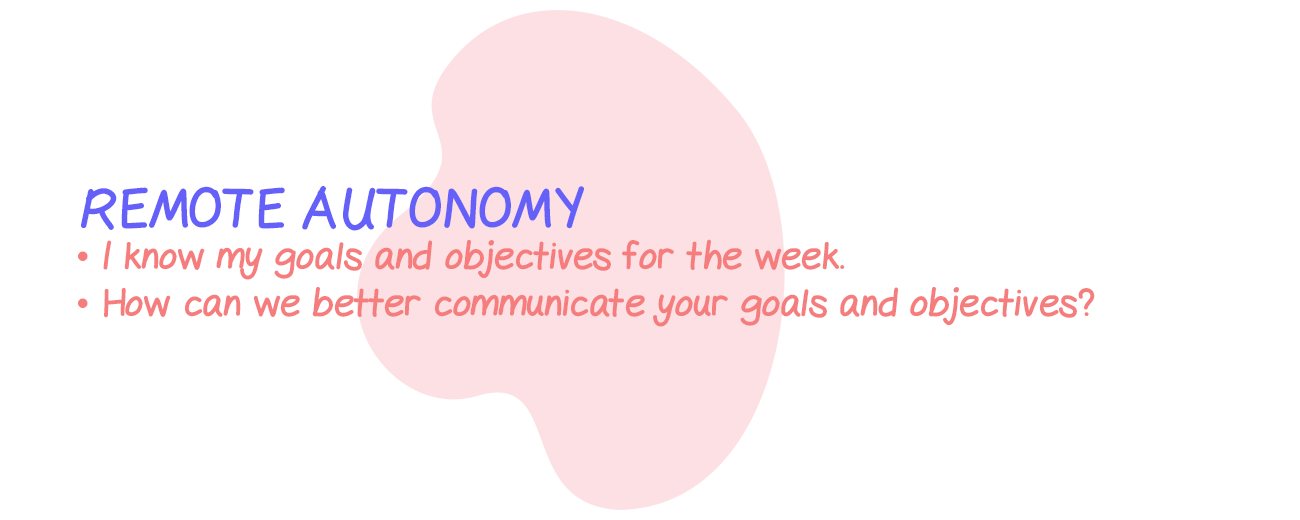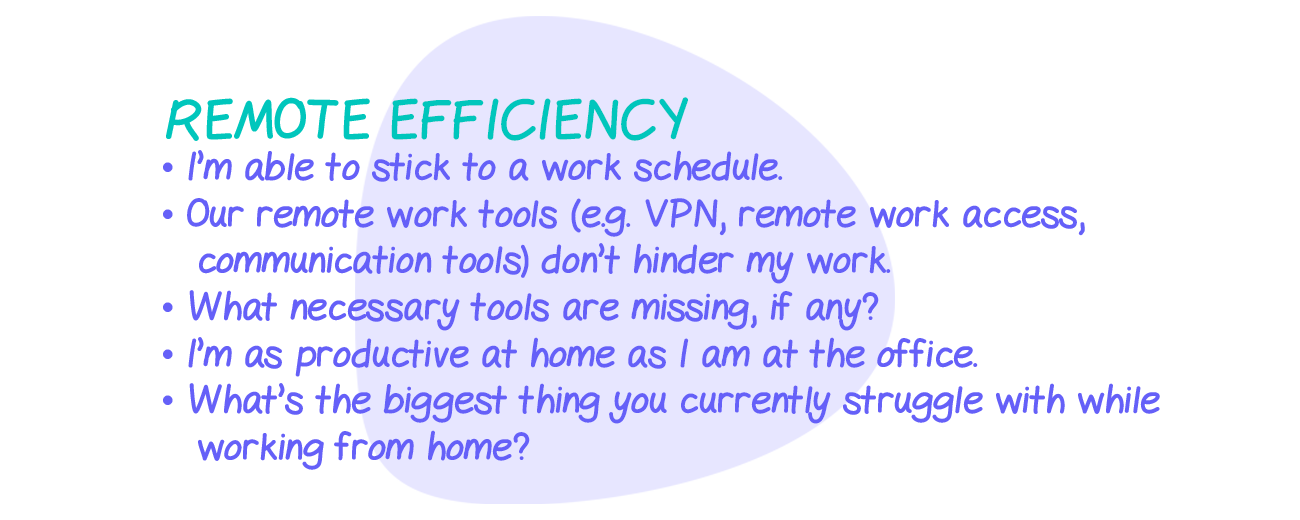Pat yourself on the back and send a thank you email to your IT team.
You did it. You transitioned hundreds of employees over to remote work, and your distributed staff is now operational.
But your work has only just begun. Now, you’ve got to look out for the health, happiness, and productivity of a workforce that isn’t familiar with remote work.
For many employees, the notion of logging in from their kitchen table is foreign.
Some struggle with the lack of facetime with their managers. Others aren’t aware of cybersecurity best practices.
Of course, it’s important not to make assumptions about how well your distributed team is doing.
The best way to make an assessment is to distribute a remote work survey with thoughtful questions to generate the insights your company needs. A remote working survey will allow you to:
- Assess how well employees are adjusting to remote work
- Identify the resources and tools they need to work more comfortably from home
- Benchmark your company’s work from home productivity against its work from the office productivity
In this quick guide, we walk you through 23 questions you should include in your work from home surveys.
Change is difficult for everyone.
You need to stay in the loop about how your workforce feels to be successful.
Here's how we can help you support your people through the challenges of change:
Our platform automatically surveys your employees on remote work at regular intervals (70% of our clients opt for monthly surveys).
Sparkbay then gathers the responses and, for each category, gives team managers and HR leaders a clear report with a score out of 10.
With the help of these reports, you’re able to track employee feedback on remote work in real-time, and understand your top improvement opportunities.
You can also segment your data based on manager, department, tenure and more, or benchmark yourself against companies in the same industry as yours using our proprietary dataset.

We also created a library of easy-to-implement actions from the most successful organizations to help you and your team managers learn and improve.
It’s a great way to build a culture of constant improvement, and give employees a voice that gets heard and acted on.
If you're interested in learning how Sparkbay can help you keep remote employees engaged, you can click here for a demo.

Assessing remote autonomy
- I know my goals and objectives for the week.
- How can we better communicate your goals and objectives?
Why are these questions important?
Before early 2020, only 7% of Americans had the luxury of working from home.
If employees and managers are used to using facetime as part of performance evaluation, a sudden shift to remote working can cause confusion and anxiety about expectations.
This uncertainty can impact performance.
What do you do if the responses are negative?
- Schedule fixed weekly meetings to set expectations. What do you expect your employees to complete? Which projects and tasks are top priority? What are the deadlines? Your employees may be working hard on a specific task at home only to later learn you were waiting for something different. This causes frustration for managers which causes anxiety in employees.
- Ask employees to flag any confusing instructions. Give employees the chance to ask questions about expectations. One-on-one virtual meetings can garner the best results.

Assessing the efficiency of a distributed workforce
- I’m able to stick to a work schedule.
- Our remote work tools (e.g. VPN, remote work access, communication tools) don’t hinder my work.
- What necessary tools are missing, if any?
- I’m as productive at home as I am at the office.
- What’s the biggest thing you currently struggle with while working from home?
Why are these questions important?
Remote working may liberate employees from cubicles and commutes, but it can also introduce unexpected limitations.
The first limitation is access to a strong internet connection. An employee who primarily worked from the office may not have an unlimited internet plan at home, forcing them to go over their monthly limit.
Some employees may not have an incredibly fast or dependable internet connection, depending on where they live.
When it comes to remote working, speed and reliability are key. Employees need a bulletproof internet connection to participate in video calls, upload work, download company files, and more.
Ensuring employees have the right tools is also important from a cybersecurity point of view. If company-approved VPNs give employees issues, they may seek workarounds that compromise the company’s cybersecurity. If companies haven’t performed VPN stress tests in the past, they may have an overloaded system that slows everyone’s work down.
Aside from technology, companies also need to assess whether their employees feel like they can comfortably work from home.
In the popular imagination, a remote employee holds a child in their lap while logging into a video conference or bottle feeds their baby while flipping through documents.
In truth, remote workers need a dedicated space within their house where they can complete focused work, free from distractions.
Ideally, a remote worker has childcare whether it’s their partner or a babysitter. So a remote survey can help employers assess whether employees feel more productive working from the office or working from home.
What to do if the responses to these questions are negative?
- Touch base with IT: Bring employee feedback to your IT team to see if there are better tools available.
- Create educational resources: Employees may be flummoxed by tech problems they could easily solve with the right instructions.
- Consider offering extended benefits or stipends: Companies save, on average, $10,000 per employee per year on real estate thanks to remote working. Some of this money can be reinvested into a stipend for employees’ internet or childcare expenses.
Assessing the amount and quality of remote interaction with direct managers
- I feel that I am getting enough support from my direct manager.
- How can we improve your interaction with your direct manager?
- I can connect with my direct manager as well as if I were in the office.
- I’m happy with how frequently I connect with my direct manager.
Why are these questions important?
Studies show that remote working is more productive.
There’s also evidence that remote working can improve employee retention by reducing turnover due to factors like long commutes, starting a family, or moving outside of a city center.
But this depends on a strong remote working strategy. Working from home eliminates the pain of a commute, but it doesn’t remove the need for sufficient interaction with managers.
Managers significantly impact levels of employee engagement. Up to 70% of the variance in employee engagement scores is due to who the boss is.
And we already know that poor managers cost businesses billions of dollars each year.
In other words, being an excellent manager is just as, if not more, important when managing remote employees. To avoid disconnected and disengaged employees, companies need to assess the quality of face time with managers while remote working.
What to do if the responses to these questions are negative?
- Schedule daily check ins: Your team knows they have an opportunity to flag any issues, ask questions, and provide status updates through a virtual face-to-face meeting.
- Share preferred communication methods with your team: Let employees know what the best way to reach you is at different times. If they have something urgent in the evening, tell them you prefer a text first. If they have a question during the regular work day, encourage them to message you through Slack. And make it clear that you’re always happy to hop on a video call, if needed.
- Carve out time for one-on-one meetings: This isn’t the same as your daily check-ins with your team. This is an open forum for sharing ideas, expressing concerns, discussing goals and objectives, and other conversations that an employee may not want to have in a group setting. This is also a great opportunity to praise an employee’s work.
Assessing the amount and quality of remote interaction with colleagues
- I feel that I can easily reach my colleagues.
- I feel that my colleagues keep me in the loop.
- I’m happy with how frequently I interact with my colleagues.
- How can we improve your interaction with your colleagues?
Why are these questions important?
Accessing information can be difficult for people who are new to remote work.
Newly remote workers are often surprised by just how much effort goes into getting basic information and resources they need while working from home.
In the office, an employee can walk over to a colleague’s desk and ask for what they need.
At home, they have to send an email, carefully construct the message to avoid any misunderstandings based on tone or word choice, send it, and hope the recipient checks their inbox.
In fact, the recipient has the option of simply ignoring the message until they feel like responding.
Then there’s the awkwardness that comes with electronic communication while remote working.
How often should you send messages?
What’s an appropriate hour to send an email?
What if someone misreads the tone of your email?
All of these factors can affect the productivity level of a remote team.
If there’s a high level of trust and psychological safety among the team, people are more likely to give each other the benefit of the doubt.
If there’s not a lot of familiarity among members of a team – perhaps it’s a newly assembled unit – messages can be taken the wrong way, delayed responses can be viewed as personal slights, and resentments that could have been avoided through face-to-face communication can build up.
In addition, there’s a mental health component that makes clear and effective communication with co-workers important.
We already know that social interaction is an important part of our physical and mental health. But what many people don’t know is that social interaction at work (aka making work friends) also boosts productivity and job satisfaction.
Work friends help employees get through stressful situations. They also encourage them and root for their success.
In fact, making friends at work is especially helpful for female employees trying to break the glass ceiling.
Plus, women who have strong work friendships are two times more likely than women who don’t have strong work friendships to feel highly engaged in the workplace.
The physical workplace makes it simpler for employees to form friendships. Employees work together in person on projects, go for lunch, grab coffee, commute together, and more. There’s also a chance to catch up in the elevator or the breakroom.
Remote working doesn’t offer the same opportunities for spontaneous socializing.
If workers want to build a professional relationship with their co-workers they have to rely on messaging apps and emails, which aren’t as likely to elicit a response.
This is even more difficult for newer employees who have to develop a relationship with colleagues from scratch.
What to do if the responses to these questions are negative?
- Discuss a remote working etiquette: Establish work from home norms among the team, so everyone’s boundaries are respected. This will differ from team to team. One popular norm is deciding which communication channel will be used for urgent matters (e.g. text) and which can be used for non-urgent matters (e.g. email). Another may be reminding the team to keep a team member’s time zone in mind when sending a meeting invite.
- Establish standard hours for phone calls: Set the expectation that people should be available for calls or meetings between a specific time each day.
- Encourage employees to turn on their webcam: When co-workers can see each other on screen, they can respond to facial cues, demonstrate active listening, and be more engaged than they otherwise would be if they weren’t seen. Companies can choose a video-conferencing app that allows workers to blur out the background to protect employees’ privacy.
- Make time for casual conversation: If you’re running a conference call, take a few minutes at the beginning of the call to ask employees about their weekend and chat before diving into work.
- Consider “virtual” work outings: Some companies opt for virtual pizza parties. Takeout is delivered to each team member’s house, on the company’s dime, and everyone logs into a video-conference call to chat and catch up.
Assessing the quality of remote communication among WFH colleagues
- I feel that the work from home policy is clear.
- I know what is expected of me every day.
- How can we better communicate work expectations?
- Our organization communicates efficiently.
- How can we improve communication from our organization?
Why are these questions important?
Company communication to remote workers is an integral part of a successful work from home strategy.
Companies with a hybrid model (office workers and remote workers) need to make it clear who can work from home, how to get the opportunity to work from home, when you can work from home, and what’s expected.
If employees can work remotely a couple of days a week, they may hesitate to do so out of fear that colleagues will view them as less committed to the job.
Despite the evidence that employees can be just as productive – if not more so – from home, there’s a popular assumption that telecommuters don’t work as hard.
Managers can precipitate a cultural change by encouraging employees to work from home.
One strategy is to implement “hotelling”. Instead of taking a dedicated workstation, employees share a workstation with a colleague. They then take turns coming into the office.
In this way, employees get the benefit of working from home without the judgement.
In addition, companies save on real estate costs, since they can hire more workers with less space.
Another way to encourage employees to work remotely is for managers to work remotely themselves.
In companies that operate with a fully remote workforce, establishing a work from home policy helps employees understand what’s expected from them.
It also keeps the company accountable by ensuring HR and managers work hard to create a strong, positive culture even with a fully distributed workforce.
Cybersecurity is another reason why assessing the quality of corporate communications is important.
For instance, if employees aren’t familiar with cybersecurity best practices they may access company applications insecurely (e.g. without using a VPN) or use unapproved peripheral devices on a company-issued computer.
This can increase your company’s chances of a cyber breach, which brings financial, legal, and reputational risks.
What to do if the responses to these questions are negative?
- Document your work from home policy: Make it clear who can work from home and how someone can gain this privilege. If you’re a completely remote office, ensure your WFH guide includes expectations, methods of communication, guidance on data security best practices, and any other relevant information.
- Create clear expectations around goals, objectives, and promotions: Clearly outline expectations, so employees know how they will be evaluated for future raises and promotions.
- Clearly outline approved expenses: Sure, employees may save on gas or a metropass, but they’ll incur other costs in terms of phone, internet, office space, utilities, and more. Make it clear which expenses the company will and won’t cover. Depending on your jurisdiction, asking employees to purchase their own supplies to complete work can have tax implications.
- Include information about cybersecurity best practices: Distribute clear instructions about common cyberthreats, what employees can and can’t do on company-issued devices, rules about using peripheral devices like USBs, instructions on setting up a VPN, and more.
Assessing the level of remote well-being among employees
- I’m able to create a hard line between work and home.
- I’m happy with my ability to work from home.
- How can we improve your work from home experience?
Why are these questions important?
Working from home is not a “set it and forget it” change.
In the world of glossy stock photos, working from home means rolling out of bed and sitting down at your computer in your pyjamas with a cup of coffee.
In the real world, employees have to put effort into working effectively from home and creating an appropriate “WFH environment”.
If employees don’t think of working from home as a skill to learn, they won’t actively take steps to improve.
This is where employers can step in to provide tips and guidance for making the most of their remote environment.
Without the right guidance, high performers can struggle or previously engaged employees may become more disconnected.
What to do if the responses to these questions are negative?
There’s a lot employers can do to help employees navigate this transition.
The first is understanding exactly what is causing issues for employees, which companies can learn about through their employee surveys.
An employee’s problems with remote working can include everything from getting in the zone to feeling lonely and isolated.
Once employers understand this problem, it’s important to both acknowledge the validity of the issue and then provide actionable advice.
For instance, getting into a work state of mind is a real problem for people who are used to working in an office environment with a supervisor nearby. Advice for workers in this situation includes:
- Never working from bed: It’s important to make a clear separation between relaxing/personal time and work time. Getting out of bed also creates a physical cue that it’s time to get to work.
- Creating a dedicated work space: This could be anything from an entire home office to a corner of the kitchen table. The idea is to have an area of your home specifically dedicated to work.
- Getting ready for work: There’s no need to put on an entire suit, but taking a shower and changing out of pyjamas every morning helps employees become more present.
- Setting daily work hours: Establish a clear start and end to your work day after which you don’t answer emails or take calls
- Changing your environment: Encourage employees to occasionally work from a coffee shop or a restaurant to avoid loneliness and isolation, so long as they follow cybersecurity best practices like using a company-approved VPN
It’s easy to fall into the habit of working from bed or staying up until 3 am to finish projects.
So even though these sound like common sense tips, it’s important to reinforce them through your team meetings and communications to employees, so they stick.
Remote work is the future of work – so make your distributed staff as happy and effective as possible
Remote work is the future of work.
Employers can hire talented candidates outside their immediate geography.
Employees can eliminate gruelling commutes, improving both their happiness and job satisfaction.
Plus, companies can save on real estate by hiring more workers than they can physically hold.
That said, remote work isn’t a panacea. It takes effort to build a distributed workforce that communicates clearly, works effectively, and feels connected as a company.
To do this, companies need to understand what their employees need. To understand what their employees need, companies need to ask them.
A tool like Sparkbay allows companies to distribute anonymous surveys to their entire remote workforce.
Employers can quickly learn how their remote staff is doing, what they need, and how they can support them.
If you're interested in learning how Sparkbay can help you keep remote employees engaged, you can click here for a demo.

